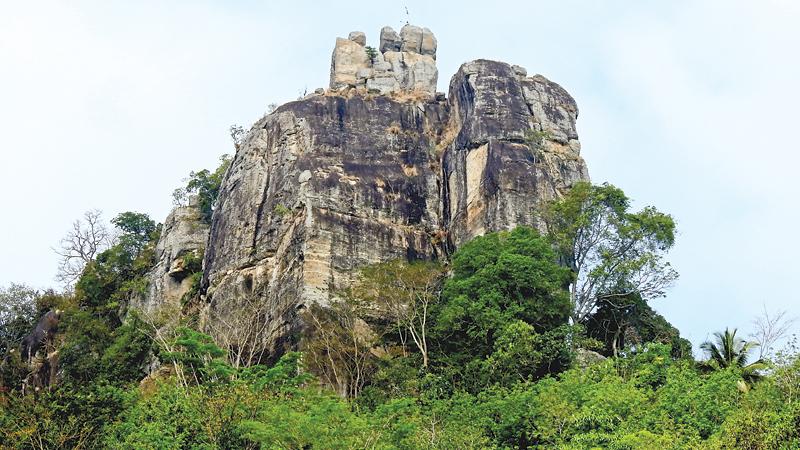
Uthuwankande Sura Saradiel who was sent to gallows 159 years ago, on May 7, 1864 was a brave gang leader or bandit who became known as the ‘Robinhood of Ceylon’.
Whenever you travel along Colombo-Kandy road you would catch a glimpse of the chimney like rock known as Uthuwankanda that stands 1,410 feet above sea level.
Saradiel was born in1832 and died in 1864. His father Adasi Appu was a carter. His mother was Pichohamy.
The young Saradiel began his early studies at the Beligammana temple and Illukgoda temple. He was a mischievous boy from his childhood.
When he was studying at Illukgoda temple, he was taken into custody by the Police on the charges of assaulting a student of a rich family. He was warned and set free. That was the end of his education.
He left for Colombo in search of a job. He found a job as a barrack boy at the Ceylon Rifle Regiment. He learnt the art of using a gun and other weapons from the Malay soldiers. One day, Saradiel was caught in the act of committing theft and was dismissed. He returned to his father who was at Chilaw, but his father refused to give him shelter.
Gang of robbers
 Saradiel |
Then he turned to Uthuwankanda. He formed a gang of robbers, made raids on carriages and coaches on the highway to Kandy from Colombo. Soon their attacks spread to Rambukkana, Polgahawela and Kurunegala. The British administration had to take steps to increase the Police units in the area.
A new hamlet called “Saradiel village” has been created at the foot of the Uhuwankanda on a land of about six acres. Saradiel’s life from his childhood to his execution is depicted in this village with life size concrete figures and structures. This has become a popular place among local and foreign tourists.
Saradiel had become popular among villagers as a figure who supported the poor and the downtrodden by robbing the British administrators and their natives. He had become a great challenge to British administrators.
In an effort to capture Saradiel, he was surrounded at his mother’s home, when he visited her.
In a shootout that ensued he escaped and made his way to Matale.
At this point Sirimala, one of Saradiel’s band defected and became an informant to the Police.
Due to superstition, he was believed to have the power of not being seen and that he was bullet proof. Many believed that this is because he had Henaraja Yantharaya on his arm which lent him such power.
Police round up
On March 25, 1864, he was drawn to a house in Mawanella. On a tip off, Police surrounded the house. They found Saradiel there with Mummale Marikkar.
Sergeant Mahart fired at Saradiel first and wounded him. Mummale Marikkar fired killing constable Shaban. Escaping from the house, Sergeant Mahart stood guard outside the only door preventing the bandit’s escape.
Assistant Government Agent Kegalle F.R.Saunders soon arrived on the scene with a detachment of Ceylon Rifles. Seeing that resistance was futile, the two surrendered.
Taken to Kandy, they were tried at the Kandy Assize by an English speaking Jury before Justice Thompson with Richard Morgan prosecuting as crown advocate.
The jury found them guilty. Both were sentenced to death. They were taken to gallows in a procession on May 7, 1864 with many coming to see the famed Saradiel.
Constable Shaban was the first Police officer in the Ceylon Police service who sacrificed his life while on duty and as a mark of respect, a monument has been constructed in the Mawanella town. Before execution, Saradiel addressed the crowd and said: “Dear friends, don’t do foolish things as I did. I did all these to earn a name. Actually, I earned a name.
But it was a destructive one. I feel sorry for the life I spent as an outlaw. But I don’t feel any sorrow for having paid compensation for it like this.”

